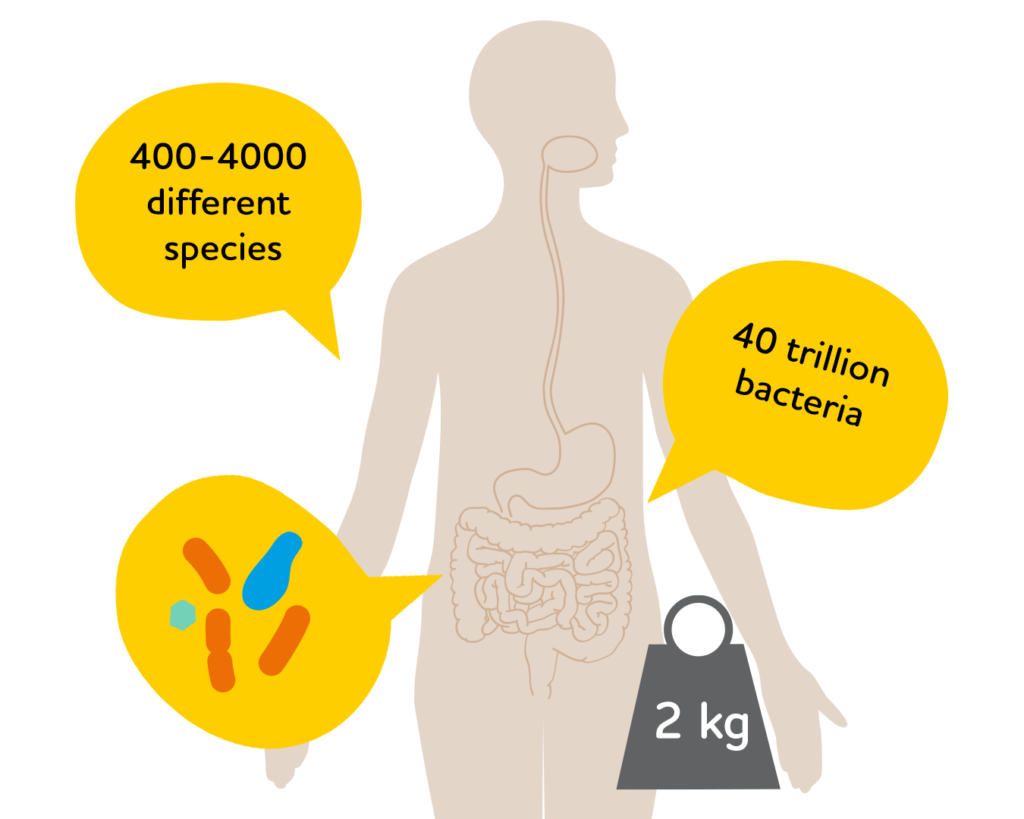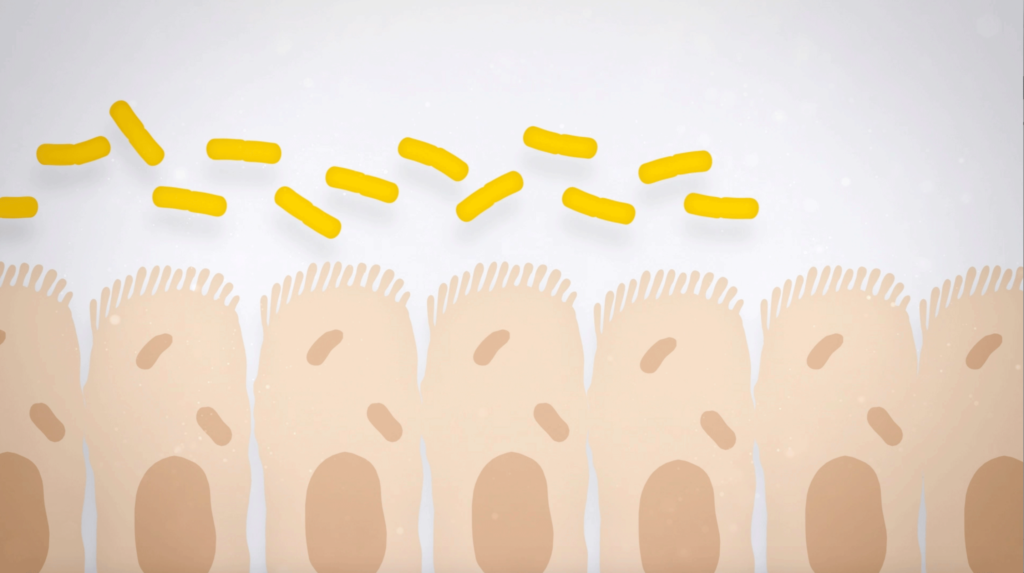The good bacteria we can’t live without
It wasn’t so long ago that all bacteria were thought to be bad since the first bacteria we were able to identify were pathogens that caused illnesses and infections. Today, we know that most bacteria are either completely harmless or even vital to our health. In the same way that we cannot live without air and water, we cannot live without bacteria. A key function of our bacteria is to support the immune system and protect us against diseases.
Our bacteria:
- Are the first line of defense against bad bacteria, pathogens
- Support and educate our immune system
- Help with the digestion and absorption of nutrients
- Produce certain vitamins, such as vitamins B and K
- May even affect our brain and, thereby, our mood
Bacteria in the human body
Previously, it had been widely reported that humans carry ten times as many bacteria cells as body cells. However, according to new findings, it turns out that there are twice as many bacterial cells as there are human cells in our bodies. These bacteria are called the human microbiota, and they are essential for our health.
Our microbiota:
- Consists of some 40 trillion bacteria, most of which are located in our gastrointestinal tract
- Consists of 400-4000 different species
- Weighs approximately two kg
- Is considered to be an “essential organ” and essential for human health

Good health starts in the gut
80% of your immune defense is located in your gut. A well-functioning immune system relies on having enough good bacteria in the body and a balanced microbiota. The good bacteria in your body prepare your immune system to combat unwelcome invaders like bad bacteria and toxins. In order to maintain a healthy balance, good bacteria must outnumber bad bacteria twenty to one.
An imbalance in the digestive system may occur if, for whatever reason, bad bacteria exceed the amount normally present. This is known as dysbiosis. Symptoms of dysbiosis include diarrhea, constipation, bloating, temporary stomach pain, and a leaky gut.
New research suggests there might be a strong link between an unbalanced microbiota and diabetes, obesity, and heart disease. In fact, studies indicate that improving microbiota health can even prevent these conditions.

The impact of modern lifestyle on health
In the last 50 years, the way we live has changed dramatically. Modern lifestyle, increased urbanization and our altered eating habits have resulted in a microbial imbalance.
- Using antibiotics and other drugs – antibiotics kill both pathogens and good bacteria.
- The excessive use of germ-killing detergents, sanitizers and soaps depletes our microbiota.
- C-section birth – babies are not exposed to the beneficial bacteria that are present in their mother’s birth canal when born by Caesarean section.
- Fast food, processed food, coffee, and alcohol are all detrimental to our gut bacteria. Our gut bacteria feed on fibre, which is found in fruits and vegetables.
- Sleep deprivation and stress are both linked to changes in microbial composition and reductions in microbial diversity.
- While exercising regularly at the gym is beneficial for your general well-being, many professional athletes often exercise at a level that damages their microbiota and puts their immune system under stress, making them more susceptible to infection.
The gatekeepers in your gut
Your gastrointestinal tract is lined with epithelial cells that function like a skin on the inside. Its main function is to determine what should be absorbed and what should not be absorbed into your body. This is assisted by gatekeepers, known as tight junctions. Your digestive system uses them to allow nutrients, vitamins, and water through and prevent things like toxins and pathogens from getting through.
A well-balanced microbiota contributes to making the epithelium stronger, tighter, and more efficient. A gut imbalance, on the other hand, damages epithelium cells, resulting in a leaky gut. A leaky gut occurs when the gatekeepers – or tight junctions – allow substances to move from the GI tract into your body and into the bloodstream. Inflammation, allergy, intolerance, and digestive problems such as IBS are just a few of the conditions that a leaky gut may result in.

Good bacteria
Good bacteria can be found in food. Before refrigerators and freezers, people used bacteria in fermentation to extend the shelf life of food. Fermented foods include yoghurt, sauerkraut, and pickled vegetables. Common lactic acid bacteria used for fermentation are Lactobacillus acidophilus, Lactobacillus bulgaricus and Streptococcus thermophilus.
Probiotics are live bacteria that restore the microbial balance in the body and there by benefit our health. In most cases, they are consumed as food supplements. Examples of common probiotic strains are Limosilactobacillus reuteri Protectis, Lacticaseibacillus rhamnosus GG and Bifidobacterium animalis ssp. lactis BB-12.
Bad bacteria
Only a small percentage of bacteria on earth are pathogenic, meaning they may cause disease. For example, food poisoning may be caused by E. coli and Salmonella, sepsis may be caused by S. aureus, and S. pneumoniae may lead to pneumonia.
It’s important to remember that bacteria of the same species, but of different strains, can behave very differently. Some species, like E. coli, harbor strains that are pathogenic, like EHEC and ETEC, which can cause severe diarrhea. On the other hand, some strains of E. coli are commensals and are among the most prevalent bacteria in our digestive tract.
Bacteria – a prerequisite for life
Bacteria are a type of microorganism* that is essential for human health. Some billion years ago, bacteria were the first form of life to populate the earth, and they continue to dictate our existence today. Humans and bacteria have coexisted throughout evolution. We share a symbiotic relationship with L. reuteri, a bacteria that is very important to our health.
Bacteria can be found everywhere, including in soil, water, snow, and even volcanoes. Some bacteria live in and on animals and humans. When a baby is born, it is almost sterile. Soon after, bacteria begin colonizing the baby's skin, mouth, and, most importantly, the digestive tract. Bacteria increase in diversity and number until about the age of three and then remain the same, more or less, throughout life.
*A microorganism, which is also called a microbe, is a living organism that is microscopic in size and invisible to the naked eye. Bacteria, fungi, protozoa, algae, and viruses are all examples of microorganisms.. Read more
Learn more
Does my baby have colic?
Directly after birth the newborn baby is almost sterile but very soon bacteria start to colonize every part of the body – the skin, the mouth and most importantly the gastrointestinal tract.
Read more
What are probiotics?
Probiotics are good bacteria that are found in food or supplements. The definition is ”Live microorganisms that, when administered in adequate amounts, confer a health benefit on the host.” (WHO/FAO, 2002)
Read more
